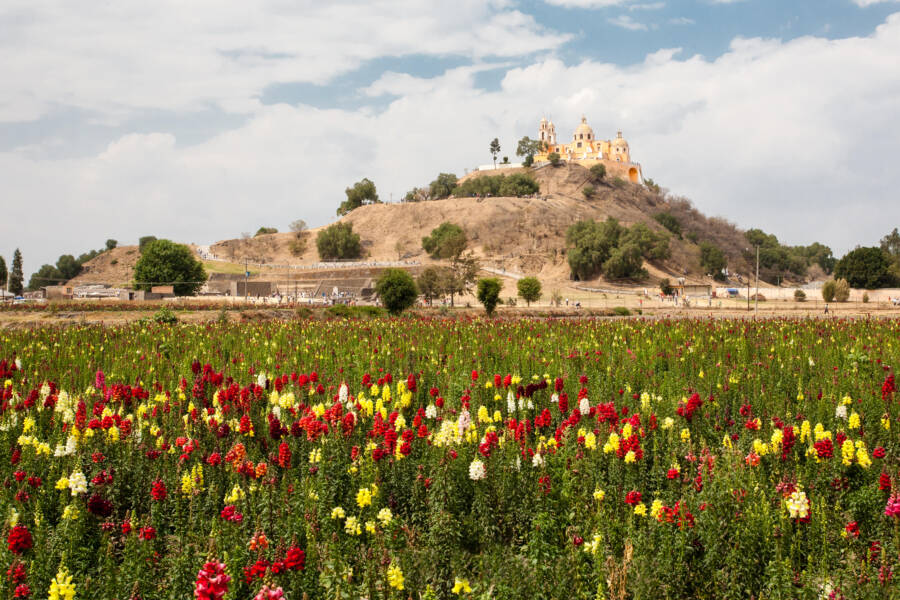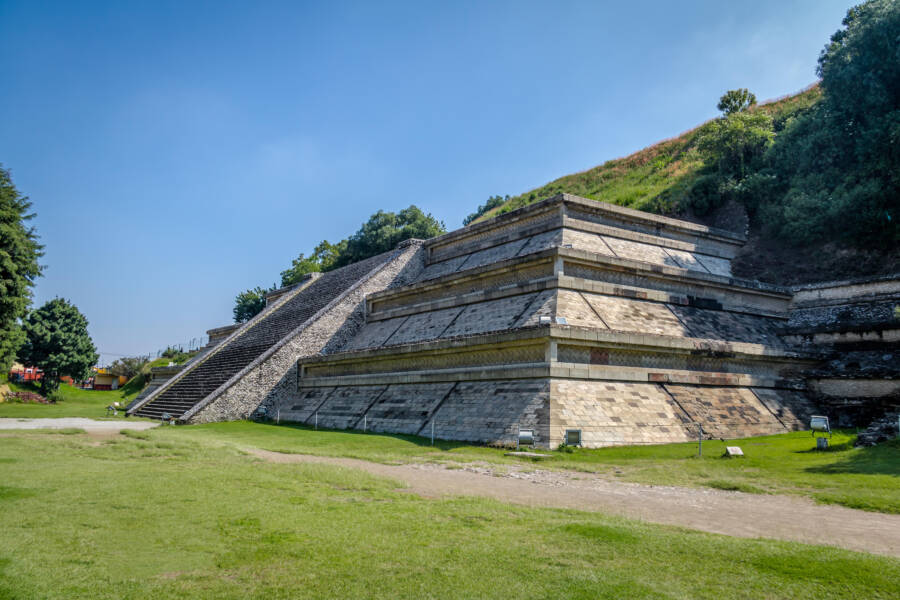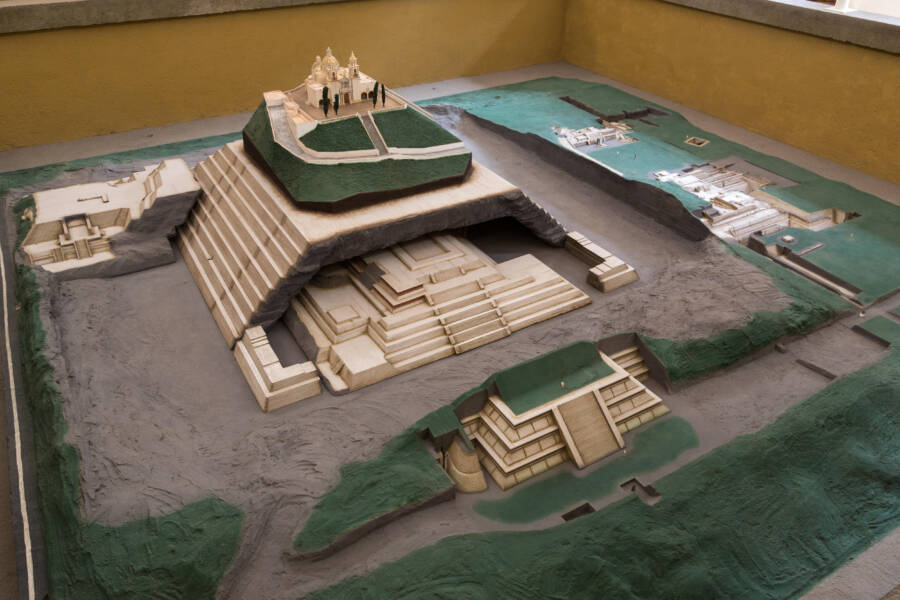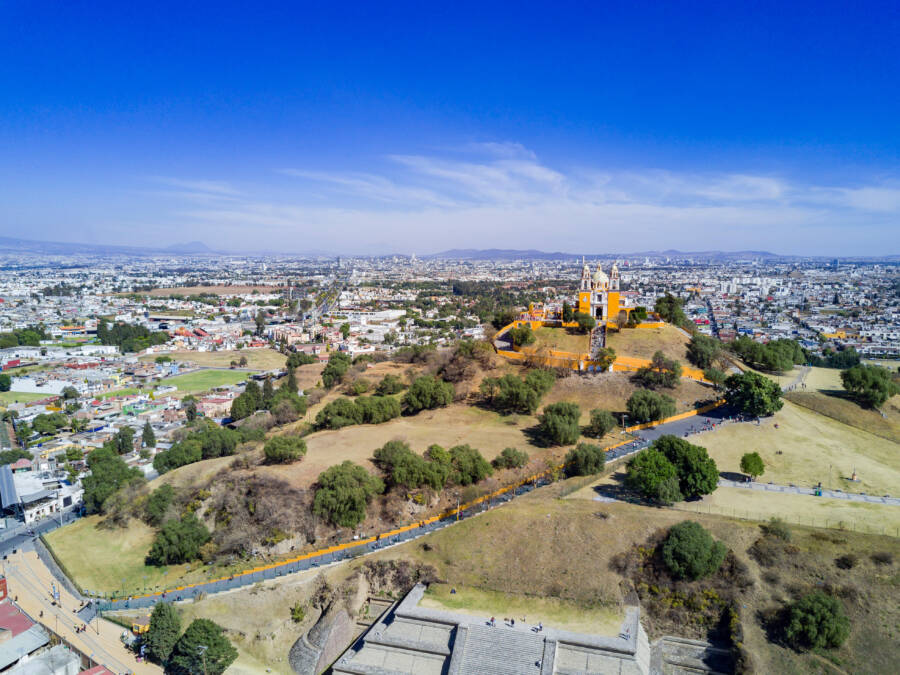Spreading across 300 by 315 meters with a total volume of 4.45 million cubic meters, the Cholula Pyramid in Puebla, Mexico was widely mistaken for a hill for centuries.

AlamyThe Great Pyramid of Cholula, Mexico.
Though the Great Pyramid of Giza in Egypt may claim the title of the tallest pyramid in the world, it is not, in fact, the largest pyramid in the world. That honor goes to the Great Pyramid of Cholula, located in Mexico.
The Cholula pyramid reaches only 66 meters tall but covers a vast amount of ground, spreading across an area of 300 by 315 meters. Its total volume has been measured at 4.45 million cubic meters, making it almost twice the size of the Great Pyramid of Giza.
But despite its impressive size and the incredible amount of effort required to build it, the Great Pyramid of Cholula was essentially abandoned just a few hundred years after it was finished.
In the years afterward, nature began to reclaim the area, and the pyramid became overgrown. And though it was rediscovered in the 19th century and has undergone excavation in the decades since, much of the site remains undisturbed.
If one were to visit it today, from certain angles, it might appear as if there was no pyramid at all — just a church sitting on a grassy hilltop.
This is the story of how the Cholula pyramid was built — and how it became known as the “made-by-hand mountain.”
The Building Of The Great Pyramid Of Cholula

AlamyThe partially excavated remains of the Great Pyramid of Cholula in Mexico.
Rather than the epic culmination of a singular vision, the Great Pyramid of Cholula was a complicated and multi-stage project that took around 1,000 years to complete.
Situated in the east-central region of Mexico, the city of Cholula today is a decently sized metropolitan area, but a little over a millennium ago, it was one of the most impressive cities in the region. Aztec History reports that at its peak, Cholula was the second-largest city in Mexico with up to 100,000 residents.
According to Mexico: From the Olmecs to the Aztecs, the city was also dedicated to the god Quetzalcoatl, a plumed serpent god of wind and rain, and so the Great Pyramid of Cholula is as well.
The Cholula pyramid took centuries to build, growing larger and more impressive over the course of four different major construction phases and nine modifications. Each phase reflected architectural styles of the time, with earlier work similar to that of the nearby city of Teotihuacán.
The first significant phase, starting around 200 B.C.E., only had a 10-square-meter base. Over the centuries, other stages added higher and wider expansions, often topped by a temple.
Finally, around 1,000 years after work began, the final addition was made. By the end, the Great Pyramid of Cholula measured 66 meters tall and had a base of around 300 by 315 meters, according to Heritage Daily.
An important center for the community, the pyramid also served as a burial site. Over the last 150 years, the remains of hundreds of bodies have been excavated there. And while some of these were regular burials, others are considered sacrifices, including several decapitated skulls of children sent as messengers to the afterlife to request an end to a drought.
But not long after it was completed, the Cholula pyramid was nearly entirely abandoned.
The Fall Of The Classic Era And The Rise Of Colonialism

AlamyA model of the grounds at the Great Pyramid of Cholula, or Tlachihualtepetl.
At some point in the second half of the first millennium C.E., for reasons unknown, Cholula’s population dropped dramatically and the pyramid was, for the most part, abandoned.
Over time, the pyramid disappeared beneath wild vegetation to the point where it resembled a large hill. It became known as Tlachihualtepetl, meaning “made-by-hand mountain” in Nahuatl, an Uto-Aztecan language.
When the Spanish arrived in the area in the 16th century, led by Hernán Cortés, they found the site overgrown. In Cholula, Cortés would massacre thousands after discovering the city’s alliance with the Aztec empire, performing an attack that could have killed as many as 30,000 of the city’s residents.
Later, perhaps believing the impressive structure they stood upon was a hill, the Spanish would destroy the much smaller existing Cholulan temple at the top of its now-overgrown peak and build a church, Iglesia de Nuestra Señora de los Remedios.
The great pyramid would remain relatively undisturbed for centuries.
It wouldn’t be until the 19th century that a thorough study of the Cholula pyramid would begin, and the world would learn about the incredible achievement of the Cholulan people.
The Cholula Pyramid Rediscovered

AlamyThe pyramid of Cholula sits beneath a church built by the Spanish in the 16th century.
Beginning around 1881, American archaeologist Adolph Bandelier started surveying the area in earnest, all the while digging up and collecting skulls. His work analyzing the Cholula pyramid would lay the foundation of its first significant excavation, which started in 1931.
That year, Arqueología Mexicana reports, a team went to work digging tunnels around the overgrown pyramid, mapping out its edges and construction.
By the time this investigation ended in the 1970s, around five miles of tunnels had been built throughout the complex.
Still, only a fraction of the temple has been explored, and its history is relatively unstudied.
Part of why the temple was never fully uncovered is that the church on top, the Iglesia de Nuestra Señora de los Remedios, is designated as having historical and religious significance. A significant structure in its own right, the church is carved from stone and ornamented with gold.
The World’s Largest Pyramid Today
Today, the pyramid is a beloved monument — and the church on top is a site of regular pilgrimage.
Tourists can visit the church above, roam the ruins themselves, and even venture into the tunnels under the pyramid, journeying back in time to see the fascinating murals and varied structures inside.
And though much of the area is accessible to the public, small-scale study and excavations continue as researchers work to uncover more of the pyramid’s secrets each year.
Though the Cholula pyramid was close to being abandoned for centuries, today it has reclaimed much of its former glory, drawing over 200,000 visitors each year hoping to see the largest pyramid in the world.
After reading about the Great Pyramid of Cholula, learn about other lesser-known pyramids, like the Nubian Pyramids of Sudan, or Gunung Padang, the oldest pyramid on Earth.





